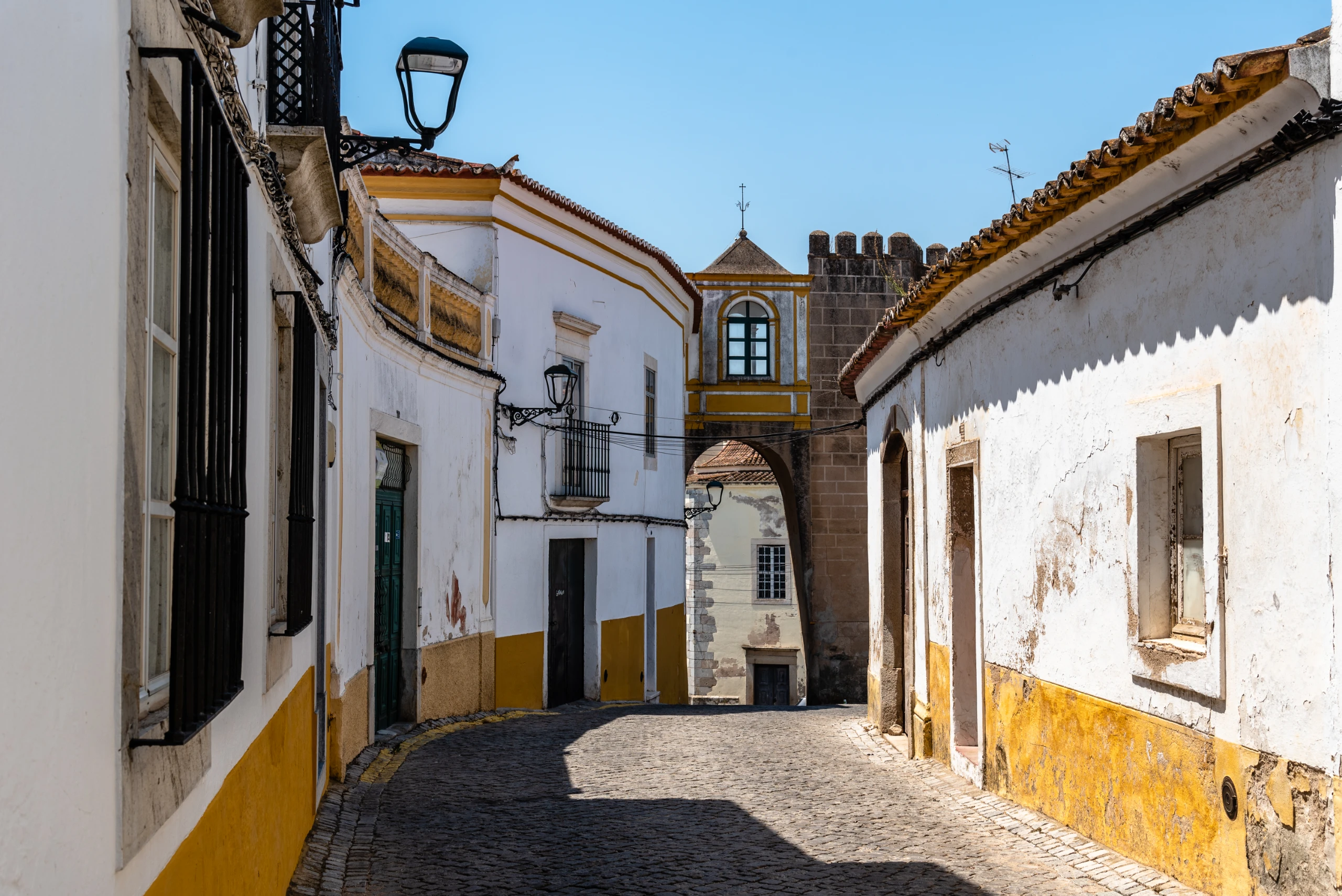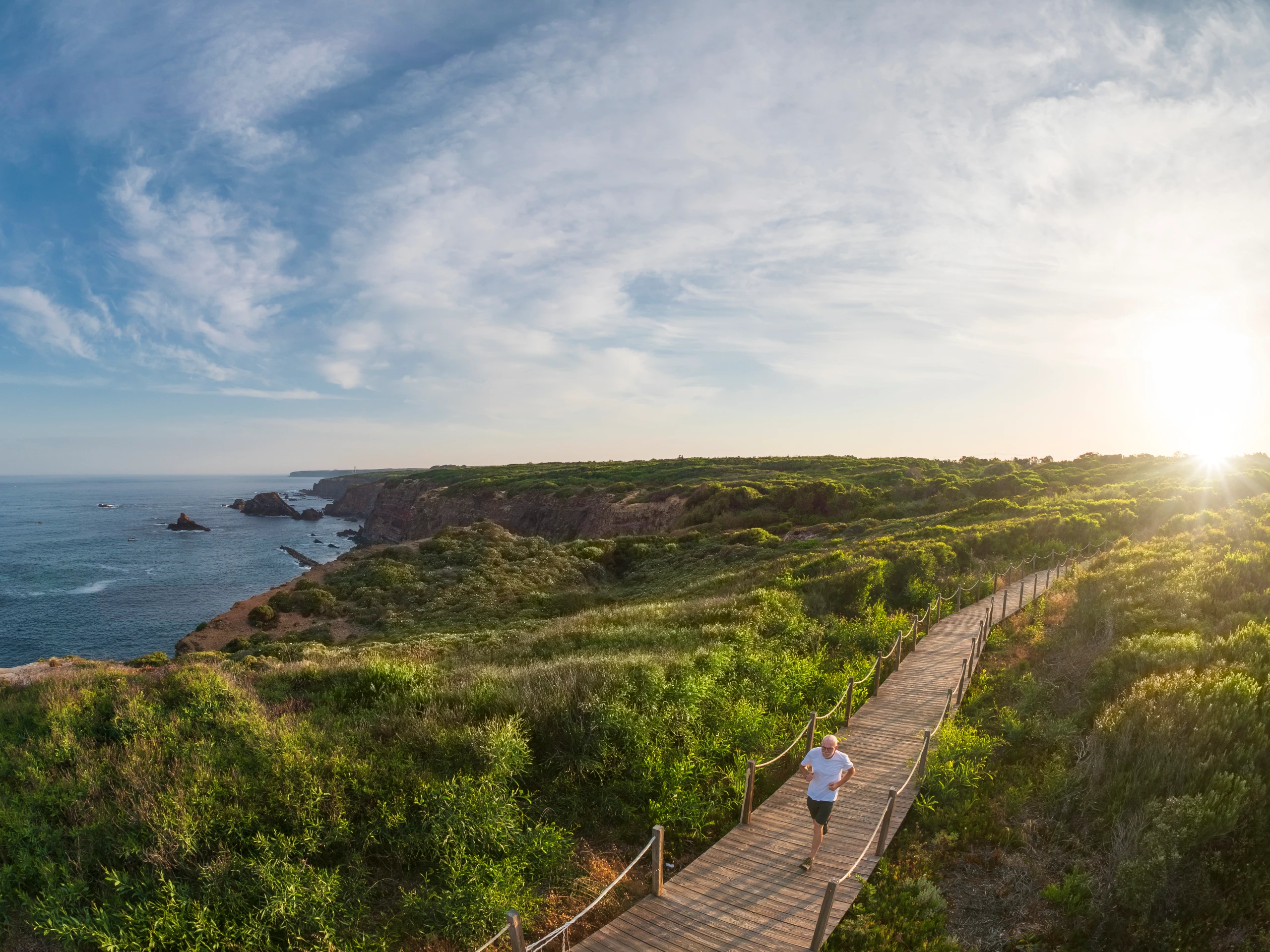Alentejo
The plains that extend as far as the eye can see start close to the Tagus. While to the north, the pace is set by the green of the flatlands, further south the landscape combines with the sun, the heat and a slower pace of life. This is the Alentejo.

The Alentejo is the largest region in mainland Portugal, covering over a third of the country’s territory. Despite its size, it remains sparsely populated, with vast open landscapes and a strong rural identity that shapes the rhythm of life here. The name Alentejo comes from “além do Tejo” (beyond the Tagus), and the region does feel like a step away from urban intensity — offering wide horizons, silence, and a slower, more grounded pace.
Geographically, the Alentejo is diverse. The northern part (Alto Alentejo) is more rugged and mountainous, especially near the Serra de São Mamede. The central plains are dominated by wheat fields, olive groves, and cork oak forests — Portugal is the world’s largest producer of cork, and much of it comes from this region. The southern part (Baixo Alentejo) becomes flatter and more arid, reflecting the Mediterranean climate that brings hot, dry summers and mild winters.
Historically, the region has deep roots in Roman, Visigoth, and Moorish occupation. Many towns still carry traces of these civilizations in their architecture, street layouts, and even agricultural systems. Évora, Elvas, and Mértola are prime examples of this layered heritage. After the Christian Reconquest in the 13th century, the region became central to the Portuguese monarchy and later to agricultural development under large estates known as latifúndios.
Culturally, the Alentejo is known for its strong sense of tradition and community. This is reflected in its cuisine, crafts, and even in the local music — Cante Alentejano, a form of polyphonic singing, was declared Intangible Cultural Heritage by UNESCO in 2014. The people of the Alentejo are proud of their land and customs, and despite the challenges of rural depopulation, many are now working to preserve and share this heritage through sustainable tourism and regional products.
For visitors, the Alentejo is a region of contrast and calm. You’ll find fortified towns, Roman ruins, megalithic monuments, unspoiled nature, and some of the best food and wine in the country. It’s a destination for those who want to go beyond the obvious — to discover Portugal at its most authentic, away from the crowds.
Main Points of Interest
Évora
A UNESCO World Heritage city and one of Portugal’s most historically significant towns. Évora is home to the Roman Temple of Diana, the eerie Chapel of Bones, Évora Cathedral, and the University of Évora — one of the oldest in Europe. The town is also a cultural centre with museums, artisan shops, and frequent academic and music events.
Monsaraz
This walled medieval village offers sweeping views over the Alqueva Lake and is one of the most picturesque places in Portugal. Its narrow schist streets, whitewashed houses, and peaceful atmosphere make it a must-see. The nearby Alqueva region is perfect for boat trips and stargazing, as it is part of a certified Dark Sky Reserve.
Elvas
A fortified city near the Spanish border with the largest bulwarked dry-ditch fortifications in the world, classified by UNESCO. Key sites include the Forte de Nossa Senhora da Graça, Forte de Santa Luzia, and the 7 km-long Amoreira Aqueduct.
Marvão
A remote and peaceful hilltop village within the Serra de São Mamede Natural Park. The medieval castle offers panoramic views across the border into Spain. The surrounding area is ideal for hiking and observing rare flora and fauna.
Vila Viçosa
Known as the “Princess of the Alentejo”, Vila Viçosa is famed for its Ducal Palace, a former royal residence showcasing opulent interiors and Portuguese history. The town is also notable for its marble quarries and historic churches.
Beja
The capital of Baixo Alentejo, Beja features a well-preserved medieval castle with a tall keep tower, the Regional Museum housed in the Convento da Conceição, and various Roman and Moorish archaeological sites.
Mértola
A small riverside town that was once a Moorish stronghold. Its Islamic past is well-preserved and celebrated through the Islamic Art Museum and architectural remains. The town’s position overlooking the Guadiana River gives it both historical and natural appeal.
Serpa
Famous for its cheese and olive oil, Serpa also has a charming historic centre with whitewashed buildings, an aqueduct, and a medieval castle. The ethnographic museum gives insight into local rural life.
Santiago do Cacém
Located in coastal Alentejo, this town combines history with proximity to the beach. Visit the ruins of Miróbriga (a Roman settlement), the castle, and the municipal museum. It’s also near the scenic Alentejo Coast, including Porto Covo and the Vicentine Route.
Castelo de Vide
A romantic village with a Jewish quarter, cobbled streets, flower-filled balconies, and a scenic castle. The local synagogue and small Jewish museum preserve the town’s Sephardic heritage.
Portalegre
Nestled at the base of the Serra de São Mamede, Portalegre has several baroque churches, a historic centre, and the Museu José Régio, dedicated to one of Portugal’s key 20th-century poets. The surrounding nature is ideal for outdoor enthusiasts.
Crato
This village has strong ties to the Order of Malta. Visit the Flor da Rosa Monastery, a unique blend of Gothic, Manueline, and military architecture. It’s also home to one of the most important music festivals in the region (Festival do Crato).
Estremoz
One of the three “marble towns” of the Alentejo, known for its castle, antique markets, and local pottery. The weekly Saturday market is a vibrant place to experience local life and produce.
Arraiolos
This small town is known across Portugal for its handmade wool rugs. Visit the Arraiolos Castle and the interpretative centre on rug-making to learn more about this artisanal tradition.
Zambujeira do Mar & the Alentejo Coast
If you venture to the Alentejo coast, Zambujeira do Mar and nearby beaches like Odeceixe and Almograve offer rugged cliffs, clean waters, and an unspoiled Atlantic feel. This is part of the Southwest Alentejo and Vicentine Coast Natural Park — ideal for coastal hiking, surfing, and wild nature.
Activities and Experiences
Wine Tasting – The Alentejo is one of Portugal’s top wine regions. Visit wineries such as Herdade do Esporão (Reguengos de Monsaraz), Adega Mayor (Campo Maior), or Quinta do Quetzal (Vidigueira) for guided tastings and vineyard tours.
Olive Oil Routes – Explore traditional olive oil production with visits to local presses, especially around Serpa and Moura.
Stargazing – The Alqueva Dark Sky Reserve offers some of the clearest night skies in Europe. Several observatories and guided night tours are available in towns like Reguengos and Monsaraz.
Hiking and Nature – Trails through the Serra de São Mamede Natural Park, the Guadiana Valley, and along the Alqueva lake offer a mix of scenery, wildlife, and rural peace.
River Activities – The Alqueva Lake, the largest artificial lake in Western Europe, offers boating, kayaking, and houseboat rentals.
Recommended Restaurants
Fialho (Évora) – A well-respected name in traditional Alentejo cuisine. Dishes like ensopado de borrego (lamb stew) and migas with pork are staples.
Café Alentejo (Évora) – More relaxed but equally authentic. Known for peixinhos da horta, açorda, and regional wines.
Sabores de Monsaraz (Monsaraz) – Excellent views and strong regional menu. Try the carne de porco à alentejana.
Páteo Real (Vila Viçosa) – Located inside a former royal stable, this restaurant offers a balance between traditional dishes and elegant presentation.
Molhó Bico (Beja) – A favourite among locals for grilled meats and hearty Alentejo flavours.
Annual Festivities
Semana Santa (Évora, Serpa, and other towns) – Traditional Easter processions with religious and cultural significance.
Festival do Crato (Crato, August) – A large-scale music festival combining international acts with regional traditions and crafts.
Festa dos Capuchos (Vila Viçosa, September) – Popular religious and cultural celebration.
Ovibeja (Beja, May) – One of Portugal’s biggest agricultural fairs, showcasing local produce, livestock, and gastronomy.
Andanças (Castelo de Vide, Summer) – A festival dedicated to music and world dances, with a focus on sustainability and cultural exchange.
Useful Tips
Best Time to Visit – Spring (March to June) and early autumn (September to October) offer the most pleasant weather. Summer can be extremely hot, especially inland.
Transport – The region is best explored by car. Public transport exists between larger towns, but connections to smaller villages are limited.
Accommodation – Rural tourism is strong here. Choose from herdades (farm stays), historic pousadas, or boutique hotels within walled villages.
Local Products to Try – Alentejo bread, sheep cheese (Queijo Serpa or Nisa), black pork (porco preto), and honey. The region is also famous for cork, ceramics, and textiles.
The Alentejo is not a place for quick tourism. It demands time, curiosity, and appreciation for detail. With its layered history, strong culinary identity, and tranquil pace of life, the region offers a deeply authentic Portuguese experience. Whether you are planning a long weekend in Évora or a full itinerary across plains and hilltop villages, the Alentejo will surprise you with its depth and sincerity — no filters, no clichés, just the real Portugal.























